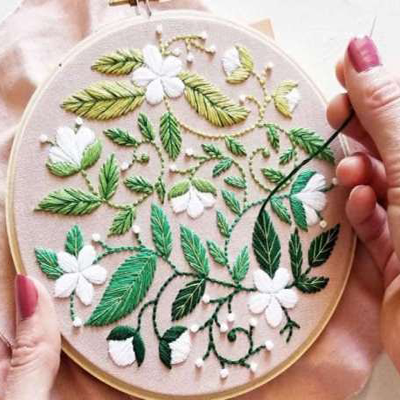
Chikankari is a traditional embroidery style from Lucknow, Uttar Pradesh, known for its delicate and intricate patterns. The process involves several steps, each contributing to the beauty and finesse of the final product. Here are the steps involved in chikankari embroidery:
1. Design Selection: The process begins with selecting a design for the embroidery. Designs can range from traditional motifs like paisleys, florals, vines, and geometric patterns to contemporary interpretations.
2. Fabric Selection: Choose a suitable fabric for chikankari embroidery. Traditionally, fine fabrics such as cotton, muslin, chiffon, georgette, silk, or organza are used. The fabric should be lightweight and easy to embroider.
3. Block Printing (optional): In some cases, the fabric may undergo block printing before embroidery begins. This step creates a pattern or grid on the fabric, serving as a guide for the embroiderer.
4. Embroidery Outline (‘Rekh’): The first step in embroidery is creating the outline or ‘rekh’ of the design using charcoal or water-soluble ink. This outline guides the embroiderer and ensures uniformity in the design.
5. Stitching (‘Taanka’): Chikankari employs several types of stitches, each with its own unique characteristics and uses:
- Bakhiya (Shadow Work): This stitch creates a shadow effect on the fabric by outlining the design from the backside.
- Hool: A variation of chain stitch used for creating patterns and outlines.
- Phanda (French Knot): Small, raised knots used to fill in the patterns and add texture.
- Keel Kangan (Thread Work): Long, darn stitches used for outlining and filling in the motifs.
- Pechni: Backstitch used for outlining and defining the design elements.
6. Filling (‘Bharat’): After outlining the design, the embroiderer fills in the patterns and motifs with stitches. Different stitches are used depending on the design and desired effect, creating a textured and layered appearance.
7. Finishing Touches: Once the embroidery is complete, any remaining ink outlines are washed off, leaving behind the intricate chikankari patterns. The fabric may undergo additional processes like washing, ironing, or starching to prepare it for the final product.
8. Washing and Final Inspection: The embroidered fabric is washed to remove any residual ink or starch. It is then inspected for quality, ensuring that the embroidery is neat, consistent, and meets the desired standards.
9. Cutting and Stitching: Finally, the embroidered fabric is cut and stitched into various garments or products such as sarees, kurtas, dupattas, or home furnishings.
Chikankari embroidery requires skill, patience, and attention to detail, reflecting the rich craftsmanship and cultural heritage of the region. Each step contributes to the timeless beauty and elegance of chikankari garments and textiles.